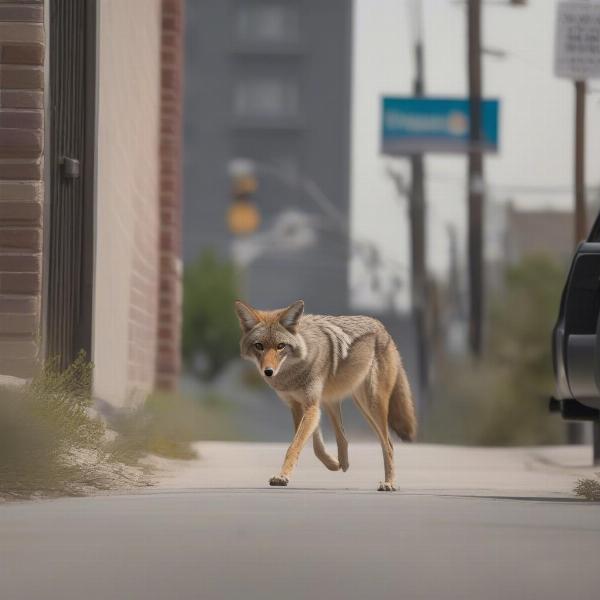Coyotes and dogs, while sharing a common ancestor, have evolved into distinct species with notable differences in their physical characteristics, behavior, and social structures. Understanding these differences is crucial for responsible pet ownership, especially in areas where coyotes and dogs might interact. This knowledge can help protect both your dog and the local coyote population.
Physical Differences: Spotting a Coyote vs. a Dog
Coyotes are generally smaller and leaner than most domestic dogs, with a pointed snout, bushy tail held low, and erect, pointed ears. Their fur is typically grayish-brown, but can vary regionally. Dogs, on the other hand, exhibit a wide range of sizes, shapes, and coat colors due to selective breeding. Dogs’ tails can be curled, bushy, or short, and their ears can be floppy or erect. A quick glance at a coyote’s more slender build and cautious demeanor can often distinguish them from a domestic dog.
Behavioral Differences: Wild Instincts vs. Domestication
Coyotes are wild animals with innate survival instincts, making them naturally wary of humans. They are crepuscular, meaning they are most active at dawn and dusk. Dogs, having been domesticated for thousands of years, are generally more comfortable around humans and have adapted to a diurnal lifestyle. This difference in behavior is a key distinguishing factor. Coyotes communicate through howls, yips, and barks, while dogs use a wider range of vocalizations, often including whines and growls, to communicate with each other and their human companions.
Social Structures: Pack Life vs. Family Life
Coyotes live in tightly knit family groups, or packs, led by an alpha pair. These packs maintain territories and hunt cooperatively. Dogs, while exhibiting some pack-like behaviors, have adapted to a more integrated social structure within human families. While some dogs might exhibit dominance hierarchies, their social interactions are heavily influenced by their relationship with humans.
Protecting Your Dog from Coyotes
Living in an area with coyotes requires responsible pet ownership. Keeping your dog on a leash, especially during dawn and dusk, is crucial. Avoid leaving pet food outdoors, as it can attract coyotes. Securely fencing your yard can also help prevent encounters. Understanding these simple precautions can significantly reduce the risk of conflict between your dog and local coyotes.
What to Do if You Encounter a Coyote
If you encounter a coyote while walking your dog, remain calm and avoid running. Make yourself appear larger by raising your arms and making loud noises. Keep your dog close and on a leash. Slowly back away from the coyote, maintaining eye contact. Do not turn your back or run, as this can trigger a chase instinct.
Conclusion: Coexistence is Key
Understanding the differences between coyotes and dogs is essential for peaceful coexistence. By respecting their wild nature and taking appropriate precautions, we can help ensure the safety of our pets and the preservation of these important predators in our ecosystems. Remember, coyotes play a vital role in maintaining ecological balance and deserve our respect.
FAQ
- Are coyotes aggressive towards dogs? While coyotes generally avoid dogs, they may become aggressive if they feel threatened, especially if protecting their pups or food sources.
- Can coyotes and dogs interbreed? Coydogs, hybrids of coyotes and dogs, can occur, though they are less common than some believe.
- What should I do if a coyote attacks my dog? Make loud noises, throw objects, and try to separate them without putting yourself in danger. Seek veterinary attention for your dog immediately.
- Do coyotes attack humans? Coyote attacks on humans are rare but can occur. Never approach or feed a coyote.
- How can I discourage coyotes from my yard? Remove attractants such as pet food, fallen fruit, and open garbage cans. Install motion-activated lights and sprinklers.
- What does a coyote sound like? Coyotes communicate through a variety of vocalizations, including howls, yips, and barks, often described as high-pitched and mournful.
- Are coyotes dangerous to livestock? Coyotes can prey on small livestock such as chickens and sheep. Proper fencing and livestock guardian animals can help deter them.
 Coyote in Urban Environment
Coyote in Urban Environment
ILM Dog is your trusted resource for expert advice on dog care, breed information, health, training, nutrition, grooming, and much more. We are dedicated to providing dog owners worldwide with practical, evidence-based information to help them raise happy, healthy canine companions. Whether you’re a seasoned dog owner or just starting your journey, ILM Dog offers valuable insights and resources. Contact us today for all your dog-related queries. Email: [email protected], Phone: +44 20-3965-8624. Visit ILM Dog for more information.